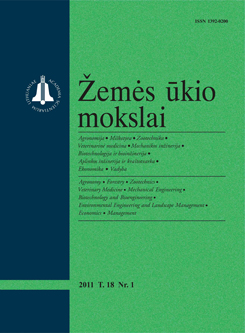 ISSN 1392-0200 |
2008 m. Nr. 3 Mineral nitrogen in Lithuanian soils
Studies were conducted in different regions of Lithuania, in soils of varying granulometric texture and occupied by different plants (winter and spring cereals, row crops, meadows and pasturelands, etc.), in spring and autumn, at a depth of 0–30, 30–60 and 60–90 cm and on 20 × 20 m plots. Besides, studies of mineral nitrogen were conducted also in a long-term field trial (38 years), applying different rates of NPK fertilizers. Based on mean monitoring data in the spring of 2005–2008, the content of mineral nitrogen (NO3 + NH4) at a depth of 0–60 cm varied from 50.2 to 62.6 kg ha–1 (mean, 55.7 kg ha–1) and depended on the intensity of agricultural activities, soil genesis and granulometric texture, amount of precipitation (r = 0.70; t = 2.91) and in individual years also on air temperature. The highest content of mineral nitrogen was found in 2005, while the lowest in 2007 and 2008. In a deeper 60–90 cm layer, the Nmin level was 11.6–25.5 kg ha–1 (mean, 19.4). In a long-term trial, under different rates of NPK fertilizers, the content of mineral nitrogen in spring at a depth of 0–60 cm depended on the rate of nitrogen fertilizers and their ratio with phosphorus and potassium, as well as on meteorological conditions in the autumn–spring period. In unfertilized plots, it comprised on average 41.5 kg ha–1, in plots fertilized every year with the mean N90P90K90 rates – 53.1 kg ha–1, while in plots fertilized with N180P90K90 – 58.7 kg ha–1. The content of mineral nitrogen at a depth of 0–60 cm in autumn versus spring in plots fertilized at average rates of N90 and high rates of N180 increased (respectively by 5.2 and 21.1 kg ha–1), and in unfertilized plots decreased (on average by 7.7 kg ha–1). In spring, before the next fertilization applying N90 and N180 rates, Nmin decreased, while in the soil of unfertilized plots it remained almost unchanged. Keywords: soil regions, soils, Nmin, rates and ratios of fertilizers |
Numeriai:
2012 - T.19 Nr.1 2011 - T.18 Nr.1, Nr.2, Nr.3, Nr.4 2010 - T.17 Nr.1-2, Nr.3-4 2009 - T.16 Nr.1-2, Nr.3-4 2008 - T.15 Nr.1, Nr.2, Nr.3, Nr.4 2007 - T.14 Nr.1, Nr.2, Nr.3, Nr.4, Nr.Priedas 2006 Nr.1, Nr.1.Priedas, Nr.2, Nr.3, Nr.4 2005 Nr.1, Nr.2, Nr.3, Nr.4 2004 Nr.1, Nr.2, Nr.3, Nr.4 2003 Nr.1, Nr.2, Nr.3, Nr.4 2002 Nr.1, Nr.2, Nr.3, Nr.4 2001 Nr.1, Nr.2, Nr.3, Nr.4 |